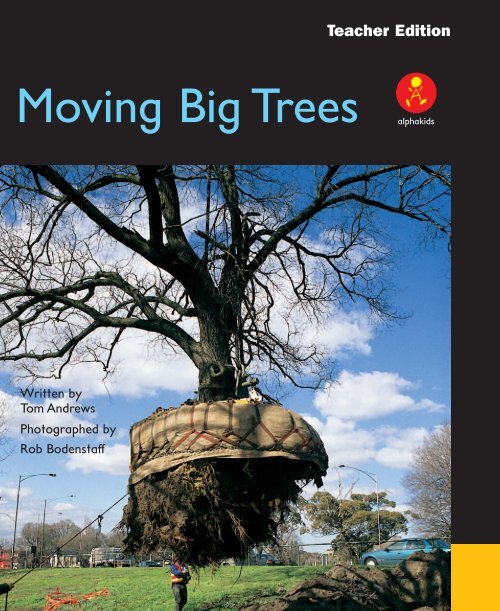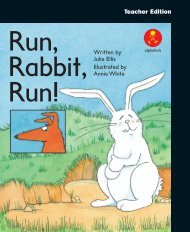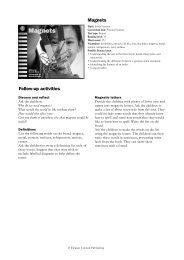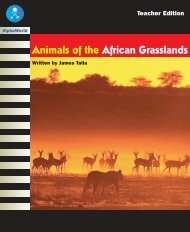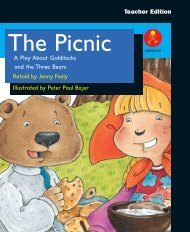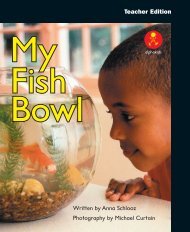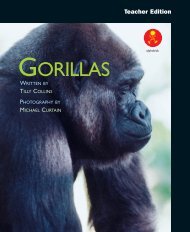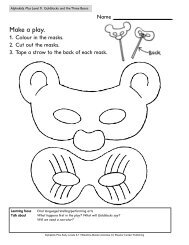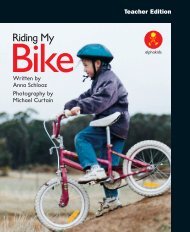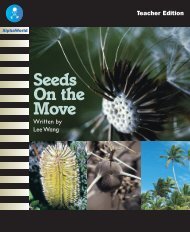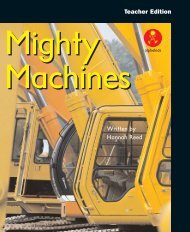Moving Big Trees alphakids - Comments on
Moving Big Trees alphakids - Comments on
Moving Big Trees alphakids - Comments on
You also want an ePaper? Increase the reach of your titles
YUMPU automatically turns print PDFs into web optimized ePapers that Google loves.
Teacher Editi<strong>on</strong><str<strong>on</strong>g>Moving</str<strong>on</strong>g> <str<strong>on</strong>g>Big</str<strong>on</strong>g> <str<strong>on</strong>g>Trees</str<strong>on</strong>g><str<strong>on</strong>g>alphakids</str<strong>on</strong>g>Written byTom AndrewsPhotographed byRob Bodenstaff
Published editi<strong>on</strong>© Eleanor CurtainPublishing 2004Text © Elizabeth GoldingPhotographs© Eleanor CurtainPublishingFirst published 2004Apart from any fair dealing forthe purposes of study, research,criticism or review, aspermitted under the CopyrightAct of Australia, no part of thisbook may be reproduced byany process, or transmitted inany form, without permissi<strong>on</strong>of the copyright owner. Wherecopies of part or the whole ofthis book are made under PartVB of the Copyright Act, thelaw requires that records ofsuch copying be kept and thecopyright owner is entitled toclaim payment.Developed byEleanor Curtain PublishingDesigned byAlexander StittProducti<strong>on</strong> byPublishing Soluti<strong>on</strong>sPrinted in ChinaISBN 0 7253 3286 71 2 3 4 5 6 7 8 904 05 06How to use this bookThe Alphakids Plus teacherediti<strong>on</strong>s support teachers as theyguide children’s reading andthinking during <strong>on</strong>e or more guidedreading sessi<strong>on</strong>s. Teachers canobserve children as they read andchoose from the given suggesti<strong>on</strong>sto suit individual needs.Before readingSetting the c<strong>on</strong>text, fr<strong>on</strong>t coverand title page:The suggesti<strong>on</strong>s help teachers toset the scene and prepare childrenfor reading the book. Prompts helpto determine children’s priorknowledge. Where necessary,background informati<strong>on</strong> isprovided. Teachers are encouragedto check that children understandthe vocabulary listed and to discussthe meanings and/or the structuresof these words. Previous experienceswith similar text types may also bediscussed.During readingPredict, Read, Reflect:Questi<strong>on</strong>s encourage children toengage with the text by makingpredicti<strong>on</strong>s. They then read asecti<strong>on</strong> of the text and reflect <strong>on</strong>what they have read. The focus is<strong>on</strong> the c<strong>on</strong>tent, language and textfeatures of the book.Observe and support:Prompts help teachers to focus <strong>on</strong>the strategies children use as theyread. Teachers can then select fromand adapt the suggesti<strong>on</strong>s accordingto the needs of the individual child.The suggesti<strong>on</strong>s aim to develop achild’s reading abilities.Interrupti<strong>on</strong>s to the child’s readingshould be minimal.After readingA selecti<strong>on</strong> of reading and writingactivities:The last pages of the teacher editi<strong>on</strong>provide follow-up activities andinclude the assessment focus.Selected text features• A flow chart is provided• Capti<strong>on</strong>s explain aspects of thephotographs• Technical language is used throughout:low-loading trucks, root ball, crane,harness, special pegs, wires, roadside,trench, base, replantedVocabularyattached, beautiful, building, council,damaged, easier, harness, preparing,several, successfully, underground
Setting the c<strong>on</strong>textHow do you think that you would move a big tree?What machines and tools would you need?<str<strong>on</strong>g>Moving</str<strong>on</strong>g> <str<strong>on</strong>g>Big</str<strong>on</strong>g> <str<strong>on</strong>g>Trees</str<strong>on</strong>g><str<strong>on</strong>g>alphakids</str<strong>on</strong>g><str<strong>on</strong>g>Moving</str<strong>on</strong>g><str<strong>on</strong>g>Big</str<strong>on</strong>g> <str<strong>on</strong>g>Trees</str<strong>on</strong>g>Written byTom AndrewsPhotographed byRob BodenstaffWritten by Tom AndrewsPhotographed by Rob BodenstaffFr<strong>on</strong>t coverAsk the children to look at the photo <strong>on</strong>the fr<strong>on</strong>t cover.What is happening? Why is the tree inthe air? What is <strong>on</strong> the bottom of thetree? Why might the tree need to bemoved?Title pageWhat equipment are they using here?How old do you think the trees might be?
<str<strong>on</strong>g>Moving</str<strong>on</strong>g> <str<strong>on</strong>g>Big</str<strong>on</strong>g> <str<strong>on</strong>g>Trees</str<strong>on</strong>g> Pages 2–5PredictWhen might trees need to be moved?Look at the pictures <strong>on</strong> pages 4 and 5.How do you think big trees are moved?Read to the end of page 5.ReflectWhy are trees moved? What are the stages of Rob’splan?Look at the capti<strong>on</strong> <strong>on</strong> page 5. Has Rob d<strong>on</strong>e this before?Observe and supportCan the child understand the text at a literal level?Why do trees need to be moved?How will this be d<strong>on</strong>e?2
<str<strong>on</strong>g>Moving</str<strong>on</strong>g> <str<strong>on</strong>g>Big</str<strong>on</strong>g> <str<strong>on</strong>g>Trees</str<strong>on</strong>g> Pages 6–7PredictHow will they prepare the trees for the move? Look atthe pictures to help you.What does the sign <strong>on</strong> the red tape tell us?Read to the end of page 7.ReflectHow did they prepare the trees for the move?Why did they need to dig a trench around the base ofeach tree?Observe and supportDoes the child integrate a range of informati<strong>on</strong> tosolve problems when they read?How did you know that word was ‘trench’? What didyou think about?4
The trees would die if they were taken straight out ofthe ground, so Rob and his team spent a few m<strong>on</strong>thspreparing them for the move.First, they dug a narrow trench around the base ofeach tree trunk.The new roots didn’t spread out underground like theold roots, but grew around each other in a big ball.The new roots made the treeseasier to move and look after.Most of the roots were cut when they dug the trench,but so<strong>on</strong> new roots started to grow.6 75
<str<strong>on</strong>g>Moving</str<strong>on</strong>g> <str<strong>on</strong>g>Big</str<strong>on</strong>g> <str<strong>on</strong>g>Trees</str<strong>on</strong>g> Pages 8–11PredictIt is now three m<strong>on</strong>ths later and time to move the trees.What equipment will they need to do this?What will they need to do to the trees <strong>on</strong>ce they havemoved them?Read to the end of page 11.ReflectHow did they move the trees?Where were the trees stored?What did they have to do to them each day?Observe and supportCan the child provide an opini<strong>on</strong> about whethertrees should be moved?Do you think that trees should be moved? Why?6
After three m<strong>on</strong>ths, it was time to move the trees.Rob and his team strapped a harness around theroots of each tree. The harness kept the soil and theroots together. This helped the trees to stay alive.The trees were very heavy. A big crane was used tolift each tree out of the ground and <strong>on</strong>to a truck.8 9The trees were taken <strong>on</strong> low-loading trucksto a nearby roadside.The team stored the trees safely by the side of theroad for several m<strong>on</strong>ths.They watered them every day.The root ball of this bigtree is almost as heavy asthe rest of the tree.117
<str<strong>on</strong>g>Moving</str<strong>on</strong>g> <str<strong>on</strong>g>Big</str<strong>on</strong>g> <str<strong>on</strong>g>Trees</str<strong>on</strong>g> Pages 12–13PredictHow do you think the trees will be moved back again?Do you think that this is an easy job?Do you think the trees will survive?Read to the end of page 12.ReflectWhat did they attach to the trees to prevent them fromblowing over in the wind? Why would they need to dothis?Observe and supportCan the child explain what new informati<strong>on</strong> theyhave learned from the book?What have you learned about moving big trees?8
After the tunnel was built, the trees were movedback to where they came from.A big hole was dug for each tree. A crane liftedeach tree from the back of a truck and put it inthe hole.12 139
The workers took the harnesses off the roots.They attached special pegs to the roots to keepthe tree in the ground.They also attached wires from the tree trunk tothe ground so that the tree would not blow overin the wind.At first the trees had to be watered every few days.Once the new roots were str<strong>on</strong>g enough to hold thetree in place, the wires were taken down.14 15It will take a few years for the trees to look justlike they did before the tunnel was built.But all the animals, birds and people who enjoythem are very pleased to have them back.1611
After readingBeing a meaning makerEncourage the children to supporttheir answers with evidence fromthe book as they discuss thesequesti<strong>on</strong>s:What needs to be d<strong>on</strong>e so big treescan be moved?Why would big trees die if they weretaken straight out of the ground?Why does it take so l<strong>on</strong>g to movebig trees?Can all big trees be moved? Why?Should people move big trees?Why?Being a code breakerExplore the following languagefeatures:• the blend ‘tr’: tree, trunk, trench,truck• words used to indicate past tense:was, moved, asked, went, made,spent, dug, were, grew, watered,took• language used to indicate order:first, after, then, whenBeing a text userDiscuss the structure of the book.How is this book organised?What comes first?What comes next?Does it matter what order eachpage is written in? Why?Why does the book finish with acomment about people andanimals?Being a text criticWhat did the author need to knowto write this book?How might he have learned aboutmoving big trees?How important are the pictures inthis book?Would the book have been asinteresting without them?12
Resp<strong>on</strong>ding to textMake models to show thesteps involved in moving abig tree. Children could work insmall groups to make their model.Provide twigs, plasticine, colouredpaper, etc. for the models.Encourage the children to writesigns and capti<strong>on</strong>s explaining theirmodels. Have the children comparetheir models to the informati<strong>on</strong> inthe book and then share them withthe class.Retell the book as a diary.Discuss what a diary is andhow you make an entry. Encouragechildren to write diary entries foreach step of the process. Share thediary with a friend.Make word lists showing pastand present tense of the sameword. For example:Present tensedigplantPast tensedugplantedDiscuss how different wordschange, e.g. by adding ‘ed’, or bychanging their spelling, such as‘dig’ to ‘dug’.Writing linksShared writingAsk children to share the featuresof a procedural text. List these <strong>on</strong>the board. Provide them withdifferent examples of proceduraltexts to help with their list.Independent writingHave the children write their ownprocedural text explaining how tomove a big tree. Display these inthe classroom.Possible assessment focusCan the child:• explain what new informati<strong>on</strong> they learned from the book?• recall the sequence of events in the book?• provide an opini<strong>on</strong> about whether trees should be moved?whole text activity sentence activity word activity
Written by<str<strong>on</strong>g>alphakids</str<strong>on</strong>g><str<strong>on</strong>g>alphakids</str<strong>on</strong>g><str<strong>on</strong>g>alphakids</str<strong>on</strong>g><str<strong>on</strong>g>alphakids</str<strong>on</strong>g>s<str<strong>on</strong>g>Moving</str<strong>on</strong>g> <str<strong>on</strong>g>Big</str<strong>on</strong>g> <str<strong>on</strong>g>Trees</str<strong>on</strong>g> <str<strong>on</strong>g>alphakids</str<strong>on</strong>g>Tom AndrewsTeacherEditi<strong>on</strong>Otherbooksat thislevel<str<strong>on</strong>g>alphakids</str<strong>on</strong>g>TheGiant’s DiaryWritten by Jack Hastings Illustrated by Steve AxelsenPhotographed byRob BodenstaffTopic: PlantsCurriculum link: Science, TechnologyText type: Explanati<strong>on</strong>Reading level: 22Word count: 435Vocabulary: attached, beautiful, building, council,damaged, easier, harness, preparing, several,successfully, undergroundThe BoyWho Wanted to beFamousWritten by Claire Halliday Illustrated by Bettina GuthridgeI Want to Be anAcrobatWritten by Tom AndrewsPhotography by Ross T<strong>on</strong>kinPossible literacy focusUunderstanding a process explained in the text.Using critical literacy skills to discuss whether alltrees can or should be moved.SocialInsectsWritten by Keith Pigd<strong>on</strong>Drag<strong>on</strong>sWritten by Jenny FeelySummaryThis book explains how a number of very big treeswere moved during the building of a tunnel, caredfor and then replanted after the tunnel was finished.ISBN 0- 7253- 3286- 79 780725 332860<str<strong>on</strong>g>alphakids</str<strong>on</strong>g>


